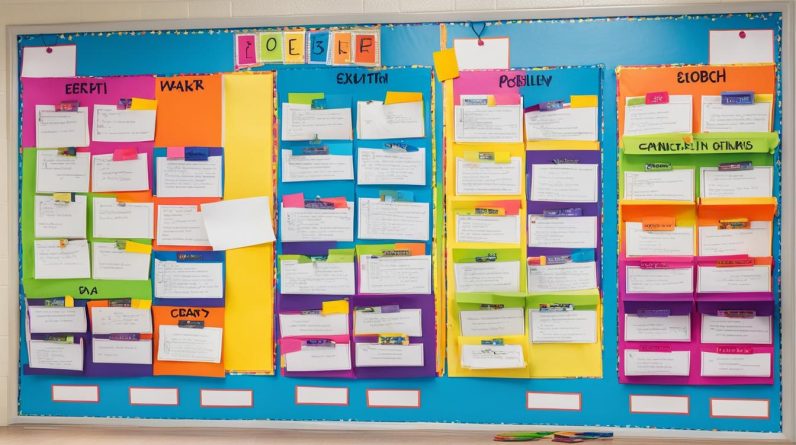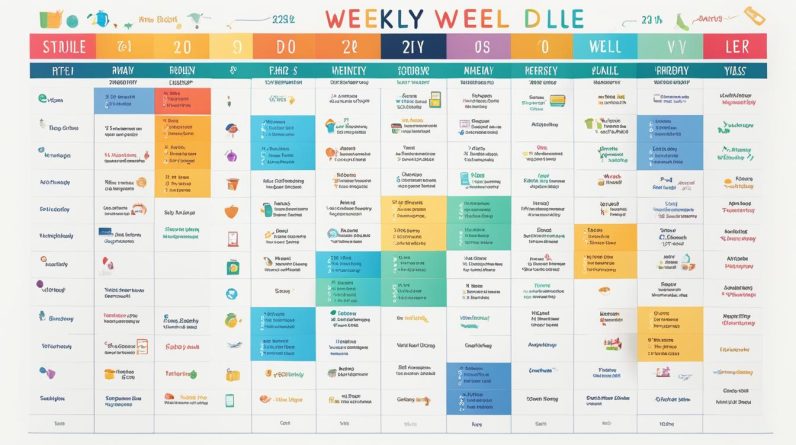Homeschooling a child with ADHD can be a rewarding experience with the right strategies and resources. It is important to understand that ADHD is a unique diagnosis that presents differently in each child. Homeschooling provides the opportunity to tailor the education to meet the specific needs of the child and create a more individualized learning experience. Here are 10 tips for homeschooling a child with ADHD:
Key Takeaways:
- Let go of a public school mindset and embrace the freedom to create a learning environment that works best for your child.
- Take a collaborative approach to learning by involving your child in the planning and decision-making process.
- Gain a deeper understanding of how the ADHD brain works to better support your child’s individual needs.
- Stay organized and develop routines to help your child manage their time effectively.
- Break tasks down into manageable steps and provide your child with a clear checklist to stay organized and track progress.
Let go of a public school mindset
Homeschooling strategies for ADHD often require breaking free from the traditional public school mindset. Instead of trying to replicate a traditional classroom environment, embrace the flexibility and adaptability that homeschooling offers to cater to your child’s unique learning needs.
When educating an ADHD child at home, you have the freedom to structure your child’s education in a way that works best for them. This means you don’t have to adhere to a rigid schedule or force your child to sit at a desk for long periods of time. Allow your child to explore different learning methods, and incorporate activities that keep them engaged and motivated.
By embracing a homeschooling approach that goes beyond the boundaries of a public school mindset, you can create an environment where your child with ADHD thrives. Let go of any preconceived notions and discover new and innovative ways to educate your child that cater to their specific strengths and challenges.
Remember, homeschooling provides a unique opportunity to tailor the learning experience to your child’s individual needs. Be open-minded, flexible, and willing to adapt your approach as you discover what works best for your child with ADHD.
Take a Collaborative Approach to Learning
Involving your child in the planning and decision-making process can greatly increase their engagement and motivation. Take the time to understand their learning style, goals, and preferences. By working together, you can create a more enjoyable and effective homeschooling experience.
Understanding Your Child
Each child with ADHD is unique, and it’s essential to recognize their individual strengths and challenges. By understanding their learning style, you can tailor your homeschooling approach to their specific needs.
- Observe how they best process and retain information. Are they more visual, auditory, or kinesthetic learners?
- Identify their areas of interest or hobbies that might serve as a basis for lesson plans or activities.
- Consider their goals and aspirations. What subjects or skills do they want to pursue?
By taking the time to understand your child, you can create a homeschooling environment that caters to their unique needs, preferences, and aspirations.
Collaborative Planning and Decision Making
Involve your child in the planning and decision-making process regarding their homeschooling journey. When they feel heard and valued, it enhances their sense of ownership and motivation.
Use the following strategies to encourage collaboration:
- Schedule regular check-ins to discuss their progress, challenges, and goals.
- Ask for their input when selecting curriculum materials or designing lesson plans.
- Encourage them to suggest learning activities or projects that align with their interests.
By involving your child in the decision-making process, you foster their independence, critical thinking skills, and self-advocacy abilities.
| Benefits of Collaborative Learning | How to Facilitate Collaborative Learning |
|---|---|
| Enhanced engagement and motivation | Encourage open communication and active listening |
| Increased sense of ownership and responsibility for learning | Provide opportunities for group projects or discussions |
| Improved problem-solving and decision-making skills | Promote collaboration with other homeschoolers or support groups |
| Development of effective communication and teamwork skills | Model collaboration and constructive feedback |
Remember: Collaborating with your child in the homeschooling process empowers them to take an active role in their education, leading to a more productive and fulfilling learning experience.
Spend time researching how the ADHD brain works
Understanding how the ADHD brain functions is crucial when homeschooling a child with ADHD. By educating yourself on the unique cognitive processes and challenges associated with ADHD, you can better support your child’s individual needs and help them navigate their own brain.
ADHD is a complex condition that affects attention, impulsivity, and hyperactivity. It’s important to recognize that every child with ADHD is different, and what works for one may not work for another. However, by gaining a deeper understanding of the underlying neurological differences, you can make informed decisions when choosing an ADHD homeschool curriculum and accessing relevant ADHD homeschool resources.
One way to delve into the world of ADHD is by consulting reputable sources such as scientific studies, books, and reputable websites. Here are some key areas to research:
- The neurobiology of ADHD: Explore how the brain functions in children with ADHD and the areas that are affected. Understand the role of neurotransmitters, such as dopamine and norepinephrine, in ADHD symptoms and executive functioning.
- Cognitive processes: Investigate the specific cognitive processes that may be challenging for children with ADHD, such as working memory, attention, and impulse control.
- Learning styles: Familiarize yourself with different learning styles and identify which approaches may work best for children with ADHD. For example, some children with ADHD may benefit from visual aids or hands-on learning activities.
- Self-regulation strategies: Learn about effective strategies for helping children with ADHD regulate their emotions and impulses. Techniques like mindfulness exercises and self-monitoring can be valuable tools in managing ADHD symptoms.
Gaining knowledge about the ADHD brain will not only empower you as a homeschooling parent but also help you advocate for your child’s specific needs. It can also guide you in selecting appropriate ADHD homeschool curriculum and resources, ensuring that you provide an engaging and effective education tailored to their unique abilities and challenges.
Remember, knowledge is power, and by taking the time to research and understand how the ADHD brain works, you can create a supportive and enriching homeschooling environment for your child.

Get and Stay Organized
When homeschooling a child with ADHD, organization is key to creating a structured and effective learning environment. By establishing a calm and clutter-free space, you can help your child stay focused and minimize distractions.
Developing routines and schedules can also be beneficial for managing time and keeping your child on track. Consistency in daily routines helps provide a sense of predictability and stability, which can be particularly helpful for children with ADHD.
It’s important to involve your child in the organization process. By giving them responsibilities and tasks related to organizing their materials and workspace, you can empower them and build their confidence. Additionally, this involvement provides an opportunity for them to develop valuable life skills that can benefit them beyond their homeschooling journey.
Pro tip: Create a checklist or visual schedule that outlines their daily tasks and assignments. This can help your child stay organized and prioritize their tasks effectively.
Remember, finding organizational strategies that work best for you and your child may require some trial and error. Stay patient, be open to adapting your approach, and celebrate the small wins along the way!
| Benefits of Organization for ADHD Homeschooling |
|---|
| Maintain focus and minimize distractions for your child |
| Promote a calm and productive learning environment |
| Develop valuable life skills and independence |
| Establish consistency and predictability in daily routines |
| Encourage effective time management |
Write out a checklist
When homeschooling a child with ADHD, breaking tasks down into manageable steps is essential for their success. One effective strategy is to provide your child with a clear checklist that outlines what is expected of them. This simple tool can help them stay organized, track their progress, and provide a sense of accomplishment as they complete each task.
The checklist should be clear and easy to understand, with specific actions or goals listed. Use short and concise statements, and consider using visual cues or icons to make it more engaging for your child. For example:
- Complete math worksheet
- Read one chapter of a book
- Practice spelling words
- Take a short break and stretch
- Write a short paragraph
By breaking down the day’s tasks into manageable steps, your child can focus on one item at a time, reducing overwhelm and improving their ability to stay on track. As they check off each completed item, they will experience a sense of progress and accomplishment, boosting their motivation and confidence.
Benefits of using a checklist:
“Having a checklist helps my son to stay focused and organized. It gives him a visual guide of what needs to be done and allows him to take ownership of his tasks. It’s a simple but effective strategy that has made a big difference in our homeschooling routine.”
– Sarah, homeschooling parent of a child with ADHD
Creating and using a checklist is not only beneficial for your child but also provides you with a tool to monitor their progress and identify any areas that may require additional support. It promotes a structured and organized learning environment, which is essential for the success of homeschooling students with ADHD.
Remember to be flexible with your checklist and make adjustments as needed. Each child is unique, and what works for one may not work for another. Tailor the checklist to your child’s specific needs and learning style, and be open to experimenting with different formats or approaches until you find what works best for them.

Start your day with movement
Physical activity plays a crucial role in supporting homeschooling strategies for ADHD students. By engaging in movement before starting the school day, children with ADHD can release excess energy and enhance their ability to focus. Encourage your child to participate in various activities such as walking, yoga, or outdoor play to help them expel their wiggles and prepare their minds for learning.

The Benefits of Morning Movement
Morning movement can have numerous benefits for ADHD students. It helps them:
- Reduce restlessness and hyperactivity
- Promote better focus and concentration
- Enhance mood and overall well-being
- Improve cognitive function and information processing
Carving out time for physical activity in the morning sets a positive tone for the day and establishes a healthy routine for your child. It can also strengthen the parent-child bond by engaging in active play together.
Choosing the Right Activities
It’s essential to select activities that resonate with your child’s interests and abilities. Consider the following options:
- Walking: Take a brisk walk around the neighborhood or park. It’s a simple, low-impact activity that gets the blood flowing and clears the mind.
- Yoga: Practice gentle yoga poses that promote flexibility, balance, and mindfulness. Yoga can help calm the mind and improve body awareness.
- Outdoor play: Encourage your child to engage in active play in your backyard or local playground. Activities such as jumping on a trampoline, playing catch, or riding a bike can provide an outlet for energy.
Remember that consistency is key. Try to incorporate morning movement as a regular part of your homeschooling routine to maximize its benefits.
Testimonial
“Before starting our homeschooling day, we always go for a morning walk. It helps my son, James, release his extra energy and get ready for focused learning. I’ve noticed a significant improvement in his attention span and overall engagement since we started this routine.”
Plan plenty of breaks
Children with ADHD benefit from frequent breaks during learning sessions. Keeping the lessons short and incorporating regular breaks can help prevent fatigue and maintain their attention. Encourage your child to engage in activities that provide a mental and physical break, such as taking a walk, stretching, or having a snack.
“Taking breaks allows children with ADHD to recharge and refocus, improving their overall productivity and learning experience.”
Benefits of breaks for ADHD students
Breaks play a crucial role in supporting ADHD students in their homeschooling journey. Here are some key benefits:
- Rest and recharge: Breaks give ADHD students the opportunity to rest their minds and recharge their energy levels, allowing them to approach the next task with greater focus and productivity.
- Regulate attention span: ADHD students often struggle with maintaining attention for extended periods. Frequent breaks help regulate their attention span, preventing them from becoming overwhelmed or frustrated.
- Reduce impulsivity: Taking breaks can help ADHD students manage their impulses and impulsive behavior. It provides them with a moment to pause, reflect, and make more deliberate choices.
- Enhance learning retention: Research suggests that short breaks between learning sessions can enhance learning retention. By spacing out learning activities with breaks, ADHD students have a higher chance of retaining information and concepts.
Homeschooling allows you to tailor the breaks according to your child’s needs and preferences. Experiment with different activities during breaks and observe what works best for your child. Remember, it’s essential to strike a balance between downtime and active engagement during breaks to optimize their effectiveness.
Sample Break Schedule
Here’s a sample break schedule you can incorporate into your homeschooling routine:
| Time | Activity |
|---|---|
| 9:30 AM | Break: Stretching exercises |
| 10:00 AM | Break: Snack time |
| 11:30 AM | Break: Outdoor play or a short walk |
| 1:00 PM | Break: Mindfulness activity or quiet time |
Feel free to customize this schedule based on your child’s preferences and their specific needs. Regularly assess and adapt the break schedule as you discover what works best for your child.

Make adjustments to the curriculum when necessary
When homeschooling a child with ADHD, it is crucial to be flexible with the curriculum and make adjustments as needed. Every child with ADHD is unique, and what works for one may not work for another. If you find that a particular curriculum or teaching method is not effectively engaging your child, don’t hesitate to explore alternative options. Tailoring the curriculum to your child’s strengths and interests can make a world of difference in their learning experience.
One great advantage of homeschooling is the ability to customize and adapt the curriculum. Take advantage of resources specifically designed for ADHD homeschooling, such as ADHD homeschool curriculum and ADHD homeschool resources. These resources provide valuable support and guidance in creating a suitable and effective learning environment for your child. They offer a variety of materials, techniques, and strategies that can help you meet your child’s unique educational needs.
Alternative learning methods can also play a significant role in supporting your child with ADHD. Incorporating hands-on activities, educational games, and multisensory approaches can enhance their comprehension and engagement. Experimenting with different teaching styles and tools will enable you to discover what resonates best with your child and facilitates their learning.
FAQ
How can I create an effective homeschool environment for my ADHD child?
Creating an effective homeschool environment for your ADHD child starts with letting go of the idea that it has to replicate a traditional school setting. Embrace the flexibility to tailor the learning environment to your child’s needs and preferences. Involve your child in the planning process and create a calm and clutter-free space that promotes focus and organization.
How can I involve my ADHD child in the homeschooling process?
Involving your ADHD child in the homeschooling process can increase their engagement and motivation. Take the time to understand their learning style, goals, and preferences. Work together to create a more enjoyable and effective homeschooling experience by allowing them to have a say in their education and incorporating their interests into the curriculum.
How can I better understand how the ADHD brain functions?
Educating yourself about the unique cognitive processes and challenges associated with ADHD can help you approach homeschooling in a way that supports your child’s individual needs. Take the time to research and learn about ADHD to gain a deeper understanding of how your child’s brain works, which will empower you to create a more effective learning environment.
How can I help my ADHD child stay organized?
Organization is key for children with ADHD. Establish a calm and clutter-free environment and develop routines to manage time effectively. Involve your child in the organization process by teaching them essential organizational skills and providing them with tools such as checklists, visual schedules, and color-coded systems to help them stay organized and on track.
How can I break down tasks for my ADHD child?
Breaking tasks down into manageable steps is essential for children with ADHD. Provide your child with a clear checklist or step-by-step guide that outlines what is expected of them. This will help them stay organized, track their progress, and give them a sense of accomplishment as they complete each task.
How can physical activity help my ADHD child with homeschooling?
Engaging in physical activity before starting the school day can help children with ADHD release excess energy, improve focus, and enhance their ability to learn. Encourage your child to participate in activities such as walking, yoga, or outdoor play to help them get their wiggles out and prepare their mind and body for learning.
Why are breaks important for my ADHD child during homeschooling?
Children with ADHD benefit from frequent breaks during learning sessions. Keeping lessons short and incorporating regular breaks helps prevent fatigue and maintains their attention. Encourage your child to engage in activities that provide a mental and physical break, such as taking a walk, stretching, or having a healthy snack.
What should I do if the current curriculum is not working for my ADHD child?
It is important to be flexible with the curriculum and make adjustments when needed. If a particular curriculum or teaching method is not working for your ADHD child, don’t be afraid to try something new. Tailor the curriculum to their strengths and interests, and explore alternative learning methods, such as hands-on activities or online resources, to support their individual needs.






